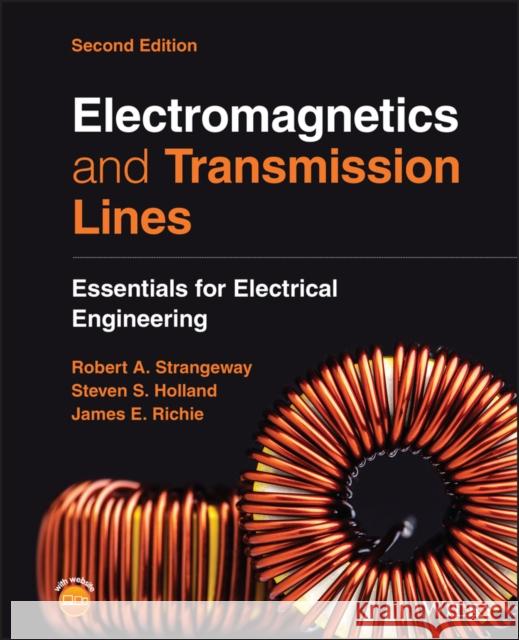Electromagnetics and Transmission Lines: Essentials for Electrical Engineering » książka



Electromagnetics and Transmission Lines: Essentials for Electrical Engineering
ISBN-13: 9781119881902 / Angielski / Twarda / 2022 / 250 str.
Electromagnetics and Transmission Lines: Essentials for Electrical Engineering
ISBN-13: 9781119881902 / Angielski / Twarda / 2022 / 250 str.
(netto: 471,18 VAT: 5%)
Najniższa cena z 30 dni: 492,70
ok. 30 dni roboczych
Dostawa w 2026 r.
Darmowa dostawa!
Preface xiiiAcknowledgments xviiAbout the Authors xixAbout the Companion Website xxi1 Vectors, Vector Algebra, and Coordinate Systems 11.1 Vectors 11.2 Vector Algebra 41.2.1 Dot Product 41.2.2 Cross Product 71.3 Field Vectors 101.4 Cylindrical Coordinate System, Vectors, and Conversions 121.4.1 Cartesian (Rectangular) Coordinate System: Review 121.4.2 Cylindrical Coordinate System 131.5 Spherical Coordinate System, Vectors, and Conversions 191.6 Summary of Coordinate Systems and Vectors 251.7 Homework 27Part 1 Static Electric and Magnetic Fields 312 The Superposition Laws of Electric and Magnetic Fields 332.1 Point Electric Charges, Coulomb's Law, and Electric Fields 342.2 Electric Charge Distributions and Charge Density 372.3 Coulomb's Law in Integral Form and Examples 382.4 Introduction to Magnetostatics and Current Density 472.5 Biot-Savart Law and Examples for Line Currents 502.6 Summary of Important Equations 562.7 Homework 563 The Flux Laws of Electric and Magnetic Fields 613.1 An Intuitive Development of Electric Flux and Gauss's Law 623.1.1 A First Look at Electric Flux Density 623.1.2 Electric Flux and Gauss's Law 633.2 Practical Determination of Electric Fields Using Gauss's Law 653.3 Determination of Charge from Electric Fields 733.4 Magnetic Flux 743.5 Summary of Important Equations 783.6 Homework 784 The Path Laws and Circuit Principles 834.1 Electric Potential (Voltage) and Kirchhoff's Voltage Law 844.1.1 Potential-Electric Field Relationship 844.1.2 Kirchhoff's Voltage Law (KVL) 864.1.3 Dielectric-Conductor Electric Field Boundary Conditions 864.2 Capacitance 874.2.1 Determination of Capacitance 884.2.2 Dielectrics and Permittivity 904.2.3 Energy Storage in Electric Fields 934.3 Resistance 944.4 Ampere's Circuital Law (ACL) 964.4.1 An Intuitive Development of ACL 964.4.2 Using ACL to Determine H 974.5 Inductance 1004.5.1 Determination of Inductance 1004.5.2 Magnetic Materials and Permeability 1024.5.3 Magnetic Field Boundary Conditions 1034.5.4 Energy Storage in a Magnetic Field 1054.6 Summary of Important Equations 1064.7 Appendices 106Appendix 4.A Dielectric-Dielectric Electric Field Boundary Conditions 106Appendix 4.B Development of Relative Permittivity 108Appendix 4.C Development of Resistance 109Appendix 4.D Introduction to Magnetic Circuits 1114.8 Homework 113Problems for Appendix 4.D 117Part 2 Time-Changing Electric and Magnetic Fields 1195 Maxwell's Equations 1215.1 Introduction to Time-Changing Electromagnetic Fields 1215.2 Faraday's Law 1235.2.1 Lorentz Force Law and Induced Voltage 1235.2.2 Time-Changing Magnetic Fields 1255.2.3 Another Look at Kirchhoff's Voltage Law 1275.2.4 Another Look at the Inductor 1285.2.5 The Ideal Transformer 1295.2.6 Mutual Inductors 1305.3 Displacement Current 1335.3.1 Time-Changing Electric Fields 1335.3.2 Another Look at the Capacitor 1345.3.3 Mutual Capacitance 1355.4 Chapter Summary: Maxwell's Equations in Integral Form 1365.5 Appendices 137Appendix 5.A A Faraday's Law Thought Experiment 137Appendix 5.B Maxwell's Equations in Differential Form 138Appendix 5.C Continuity Equation and KCL 1415.6 Homework 1426 Transmission Lines: Waves and Reflections 1456.1 Transient Waves in DC Circuits 1466.1.1 Propagation of Waves in DC Circuits 1466.1.2 Reflection of Waves in DC Circuits 1486.2 Introduction to AC Wave Phenomena 1536.2.1 Traveling Waves 1536.2.2 Wavelength and Distance Considerations 1556.2.3 Electromagnetic (EM) Fields on a Transmission Line 1566.3 Reflections in AC Transmission Line Circuits 1586.3.1 Reflected Waves and Measures of Reflection 1586.3.2 Smith Chart: Impedance and Measures of Reflection 1616.4 Scattering Parameters (S-parameters) 1666.4.1 Power, Gain, and Loss 1676.4.2 S-parameter Definitions 1706.4.3 S-Parameter Examples 1736.4.4 Vector Network Analyzer 1746.5 Summary of Important Equations 1776.6 Appendix: dBm "Dos" and dBm "Don'ts" 1776.7 Homework 1787 Transmission Lines: Theory and Applications 1837.1 A Circuit Model for AC Transmission Lines 1847.2 Voltage and Current Solutions for a Lossless Transmission Line 1867.3 Interpreting the Voltage and Current Solutions 1887.4 Lossy Transmission Line Solutions 1927.5 Practical Transmission Line Calculations and Insights 1937.5.1 Transmission Line Impedance Expression 1937.5.2 Special Case of Lossless Transmission Lines 1957.5.3 Standing Wave Patterns 1967.5.4 Reflection Coefficient vs. Position 1987.6 Smith Chart Revisited: Electrical Distance 1997.6.1 Rotation on the Smith Chart - an Electrical Distance Perspective 1997.6.2 Lossy Transmission Line Traces on a Smith Chart 2027.7 Determining Load Impedance from Input Impedance 2037.8 Summary of Important Equations 2047.9 Appendices 205Appendix 7.A Conversion of Maxwell's Equations into the Telegrapher's Equations 205Appendix 7.B Development of the Particular Solutions for T-line Waves 208Appendix 7.C Alternate Development of Reflection Coefficient vs. Position 2097.10 Homework 2108 Antennas and Links 2158.1 Introduction to Antennas 2168.1.1 An Intuitive Transition from a Transmission Line to an Antenna 2168.1.2 Antenna Concepts 2178.2 Uniform Plane Waves 2188.2.1 Comparison of Uniform Plane Wave and Transmission Line Solutions 2198.2.2 The Poynting Vector and Electromagnetic Wave Power 2208.2.3 Polarization 2238.3 Antenna Parameters 2248.3.1 Antenna Gain 2248.3.2 Radiation Patterns 2258.3.3 Radiation Resistance and VSWR 2268.4 Links 2288.4.1 Free-Space Loss 2288.4.2 Friis Transmission Equation for Link Loss 2298.5 Summary of Important Equations 2318.6 Homework 2319 Signal Integrity 2339.1 Introduction to Signal Integrity 2339.2 Transmission Line Effects 2349.3 Crosstalk 2359.3.1 Electric and Magnetic Field Coupling 2359.3.2 Shielding 2369.4 Electromagnetic Interference 2379.4.1 Overview 2379.4.2 EMI Measurements 2389.5 Power/Ground Switching Noise 2419.6 Summary of Important Equations 2419.7 Homework 241Appendix A Alphabetical Characters, Names, and Units 243Appendix B Greek Letters, Names, and Units 247Appendix c A Short List of Physical Constants 249Appendix d A Short List of Common Material Electrical Properties 251Appendix E Summary of Important Equations 253Bibliography 259Select Answers to Homework Problems 261Index 267
Robert A. Strangeway, PhD, is a Professor and Transfer Track Coordinator with the Electrical Engineering and Computer Science (EECS) Department at Milwaukee School of Engineering (MSOE).Steven S. Holland, PhD, is an Associate Professor and Electrical Engineering Program Director with the EECS Department at Milwaukee School of Engineering (MSOE).James E. Richie, PhD, is an Associate Professor and Associate Department Chair in the Department of Electrical and Computer Engineering at Marquette University.
1997-2025 DolnySlask.com Agencja Internetowa
KrainaKsiazek.PL - Księgarnia Internetowa









